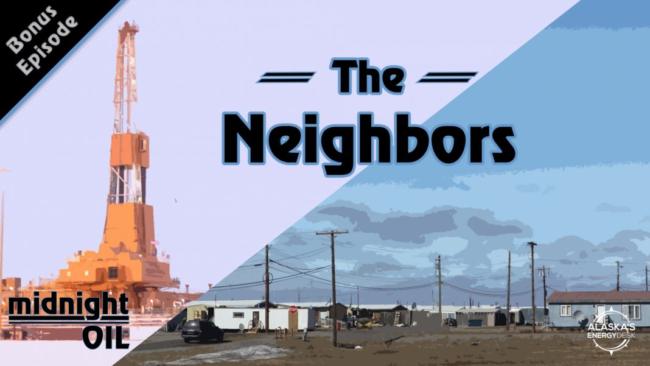
To begin to comprehend the weight of the oil industry’s presence in Alaska’s Arctic, a good place to start is a baseball field — a small, sandy baseball field in a village on the tundra, not too far from the Arctic Ocean.
Early last summer, the baseball field was the site of a celebration. Most everyone in the village of Nuiqsut, Alaska was gathered there — kids helped hang streamers and balloons, and elders, bundled up in furs and coats, sat waiting on a caribou hide with open coolers and plastic baggies, ready to receive their share of whale meat.
Later, there was a blanket toss. A circular sealskin was suspended above the ground with ropes and wooden supports at the center of the baseball field. Men and women gathered around, gripped the edges and pulled in unison. One by one, men, women and children jumped on top — and were soon catapulted into the air.
Whaling crews across the Arctic host this celebration, called nalukataq, every summer. The previous fall, Nuiqsut’s crews had boated roughly 100 miles down the nearby Colville River to the Beaufort Sea, to harvest bowhead whales.
According to one 2016 survey, nearly every household in Nuiqsut relies on whale, caribou, fish and other animals harvested near the village to eat — meat they’ve hunted themselves or shared by friends or family. In Nuiqsut, food from the land is the base of nearly every meal. That’s one of the things that makes Nuiqsut, Nuiqsut: It’s a place where centuries-old traditions are cherished, necessary and alive.
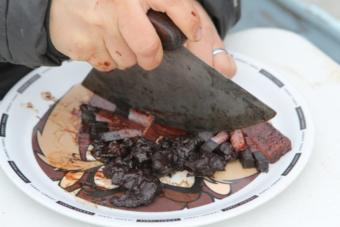
But Nuiqsut’s recent history has been defined by a different resource — one that has come to shape the community in a powerful way: oil.
During the whaling celebration, a man named Jim Winegarner strolled along the bleachers, chatting and handing out fliers. Winegarner was working for Hilcorp, a Texas-based oil company. He was recruiting for a training program for oil industry jobs.
“If we can get a bunch of people from Nuiqsut all on that same program, it’ll help you stay together. Like a whaling crew!” Winegarner said to a few residents gathered on the bleachers.
“And then you could start being a whaling captain in the oil business,” he said. “What do you think?”
Winegarner was also the man who could explain the stack of boxes arranged not far from the tables laden with pots of soup and the tubs of whale meat. The boxes were from Hilcorp, Winegarner said: “A planeload of bananas for each whaling captain.”
Call it a gesture of goodwill. Hilcorp is planning an offshore oil project about 20 miles from the island that Nuiqsut’s whaling crews use as a base camp. It’s one of a surge of new oil developments in the works in the region.
With names like Willow, Pikka and Greater Mooses Tooth 2, these new projects have been met with excitement in Alaska. Together, they could go a long ways towards reversing the long-term decline in oil production from Alaska’s North Slope, a potential boon for the state’s oil-driven economy.
But if you look at a map of where many of these oil projects are planned, there’s a dot right in the middle: the village of Nuiqsut.
Nuiqsut is small; its population is some 450 people. It’s rural: There are no permanent roads to the village. The vast majority of people who live there are Iñupiaq.
And for the past few decades, Nuiqsut has been the oil industry’s closest neighbor on Alaska’s North Slope.
For village residents, the stakes are high. Thanks to the village corporation’s ownership of a large swath of land surrounding the community, some of Nuiqsut’s leaders have leveraged benefits — financial and otherwise — for its people. At the same time, the oil projects operate on the same land where residents have long hunted and fished, creating a tension between development and subsistence.
So what does it mean to have oil companies move in nearby? What choices are you forced to make when you want to maintain your way of life, but one of the world’s wealthiest, most powerful industries is knocking on your door?
Something beautiful over the horizon
To understand how Nuiqsut ended up asking these questions, one place to start is the late 1960s — a time when the village as it is today didn’t exist.
Before white settlers colonized Alaska, Iñupiat called the Kuukpikmiut lived and hunted in the area for generations. When the federal government required Iñupiat children to go to school, many people who traditionally came from the area moved 100 miles to Utqiagvik, then called Barrow, the northernmost city in the U.S.
Then there were two seismic moments in Alaska’s history: In 1968, a giant oil field was announced 60 miles east of Nuiqsut, at Prudhoe Bay. That discovery led to the 1971 passage of the Alaska Native Claims Settlement Act.
If Alaska Native people wanted rights to their land — lest it, say, get leased out to an oil company without them having a say in it — they needed to claim it. They needed to form what are called regional corporations and, on the local scale, village corporations.
And to form a village corporation, you needed a village.
So in 1973, the Kuukpikmiut decided to return home.
The story is a legend in Nuiqsut. One person who can tell it is Isaac Nukapigak, one of the village’s original residents.
“Twenty-seven families that have a link to the Colville River made that journey, by snowmachine or any type of all-terrain vehicle that can travel through the tundra,” Nukapigak said. “Not knowing that there was oil. Because it was rich and abundant in wildlife.”
Those 27 families pitched canvas tents, on high ground safe from flooding, and lived that way through the Arctic winter, for 18 months — through blizzards and cold snaps, hunting for food, starting their own school in one of the tents.
“People were prepared. They worked together. It was one big united family — everybody took care of each other,” Nukapigak said.
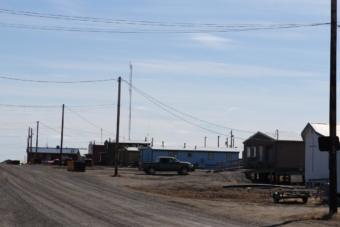
Eventually, they built a permanent community organized around a small grid of gravel roads. Now, there’s a school, a fire station, churches, a general store, a hotel and an airstrip. And Nuiqsut is still bound to the reason for its founding: According to a North Slope Borough survey, more than two-thirds of the village depends on subsistence for at least half of their diet.
They called it Nuiqsut — Iñupiaq for “something beautiful over the horizon.”
‘We are dealing with the rest of the world, not just by ourselves’
At his home in the village, Vernon Long, another original Nuiqsut settler, paged through a book he and his father contributed to, shortly after the village was established. It contained maps of the Colville River delta, the region around the village.
The river flows hundreds of miles through the western Arctic and ends at the Beaufort Sea, forming a broad mosaic of wetlands and streams that dimple a landscape that’s otherwise completely flat.
Long’s book of maps shows how Nuiqsut’s traditional hunting areas blanket the region — the places his people harvest caribou, fox, wolves, wolverine, fish, moose, polar bears, ducks and geese and, of course, bowhead whales. For subsistence hunters and fishermen, the Colville River Delta is a kind of breadbasket.
But even in the early days, people in Nuiqsut had a pretty good idea that the Colville River Delta contained another prized resource.
Long recalled a day from his childhood when his grandmother took him berry-picking outside the village.
“We ran into a little pond of water that was about six feet by six feet, bubbling!” Long said.
Long said he called his grandma over and asked her, “‘Grandma, how come this water is bubbling, grandma? Look!’”
“And she comes and she goes, ‘Wow, in the future, you’re going to be rich, grandson,’” Long said.
Long’s grandmother guessed the bubbles came from a natural gas seep. It was a clue that oil — potentially a lot of oil — lay beneath them.
“Grandma was, unbelievably, telling the truth — without realizing what it looks like today,” Long said.
It’s been more than 40 years since Long found the bubbling pond. It’s not too far a walk from his front stoop to see how things turned out.
If you stand at the north end of Nuiqsut, there’s a clump of industrial-looking buildings on the horizon — the Alpine Central Processing Facility, owned by the oil company ConocoPhillips. Alpine was the first in a steady push of oil developments north of Nuiqsut, heading west from the initial discovery at Prudhoe Bay.
Since Alpine’s arrival, there’s been a tension in the village between the old and the new, trying to work itself out.
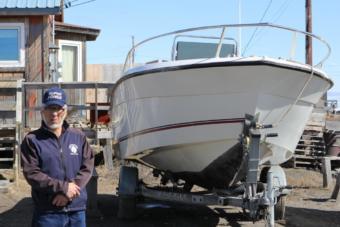
Long said he believes it’s possible for the two to meet halfway — that it’s possible for Nuiqsut to adapt to the increasing number of oil discoveries nearby.
“As we move along to our new discoveries, it pushes away from our real lifestyle, of who I really am as an Iñupiat Eskimo,” Long said. “That doesn’t mean I’m going to lose that. It just means we are dealing with the rest of the world, not just by ourselves.”
Long has woven his own life between Iñupiaq and Western ways. In front of his house, he’d parked the boats he uses to travel the river; he hunts wolverine and wolves. Inside, Long plays video games.
He’s also an artist, and as he talked, he studied an oil painting in his living room that he hadn’t quite finished. It was of a man in a fur-lined coat, standing on an icy shoreline, gazing out at a bright blue ocean and a citrus-colored sky.
Long said his painting already has a buyer: ConocoPhillips.
A ‘North Slope Renaissance’ in Nuiqsut’s backyard
In the two decades or so that Conoco and Nuiqsut have been next-door neighbors, the oil company has established a kind of empire in the area. Conoco has coined a phrase for the industry’s goal in Alaska’s Western Arctic: “The North Slope Renaissance.”
Oil was discovered near Nuiqsut in the 1990s, and the first major project — Conoco’s Alpine oil processing facility — started up in 2000. Alpine is eight miles from the village.
Since then, Conoco has connected Alpine to a growing constellation of drill sites to Nuiqsut’s north and northwest, several others also within 10 miles of the village.
Conoco has long had a major presence in Alaska. Of all the oil companies in the state, it holds the most acreage and produces the most oil. And its interest in the Western Arctic has been growing.
In July, the oil company took the unusual step of flying 30 of its biggest investors and financial analysts to Anchorage, gathering them in the company’s downtown high rise — the tallest building in Alaska’s biggest city. The company also took its visitors on a tour of the North Slope.
Joe Marushack, Conoco’s top executive in Alaska, called the meeting a “great success” at an industry conference a few months later, saying the visit helped raise the profile of the company’s “really, really massive” operations in the state.
“Alaska wasn’t really on the radar screen with our investors, but it’s a really big part of our portfolio,” Marushack said.
“They got to see just what we thought in terms of the potential, the exploration success that we’d had,” he said.
One of Conoco’s biggest projects in the works is a recent oil discovery called Willow. It’s a field about 30 miles west of Nuiqsut, with enough oil to justify building a whole new processing facility — a second Alpine.
It’s estimated it will produce approximately 100,000 barrels of oil daily — an amount worth $7 million dollars at today’s prices, and a full fifth of the crude that now runs down the trans-Alaska pipeline.
Over the past several winters, Conoco has aggressively searched for more oil, drilling more wells than it has in years. Project by project, drill site by drill site, the oil company is steadily expanding its territory near Nuiqsut.
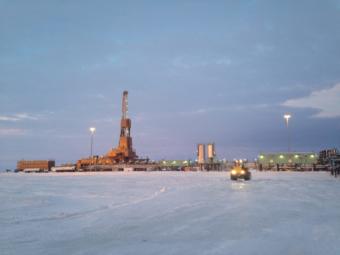
Conoco’s progress is happening despite legal challenges brought by environmental groups, which point out that before the company arrived, the area was mostly untouched by oil development. Teshekpuk Lake, to Nuiqsut’s west, is prized by conservationists for its migratory bird habitat.
But Conoco has the advantage of tremendous political support. Former Interior Secretary Ryan Zinke declared “the only path for energy dominance is a path through the great state of Alaska,” and the Trump administration is moving to open up more land near Nuiqsut to oil leasing. And in the oil-dependent state of Alaska, the phrase “North Slope Renaissance” has the ring of economic salvation.
Many of the excited conversations about Conoco’s work are happening hundreds of miles from where the company’s projects will actually be built — at the Alaska Legislature in Juneau, at oil industry conferences in Anchorage, at the company’s headquarters in Houston. For most, the drill rigs, pipelines and worker camps are out of sight and out of mind.
In Nuiqsut, it’s a different story
‘We’re surrounded by lights’
Even before the new projects are built, Nuiqsut is already the indigenous community that’s most affected by oil development in Alaska. For a village of 450, that can be overwhelming.
At the office of the Native Village of Nuiqsut, the village’s federally recognized tribal government, administrator Martha Itta described the endless parade of government agencies that show up.
“We usually have two or three meetings a week with different agencies — such as the Bureau of Land Management, the Environmental Protection Agency, the North Slope Borough, the Army Corps of Engineers, all who are responsible for permitting these projects,” Itta said.
All the proposed oil developments require federal environmental reviews before permits can be issued. And while it’s important for people in Nuiqsut to weigh in, the process can be burdensome. Thick three-ring binders in Itta’s office are filled with government analysis of the potential impacts of all the drilling, planned not far from where Itta sat.
That’s on top of the projects near the village where oil is already being drilled and pumped. Things have changed, Itta said. It’s especially noticeable when the sun stops rising during the Arctic winter.
“In the wintertime, when it’s dark, we’re surrounded by lights that, you know, growing up, they were never there,” Itta said. “There was no infrastructure, there was nothing out there but animals.”
Itta was worried about how the oil industry affects the village’s most basic needs — from the animals they harvest to feed their families to the air residents breathe.
“It’s not small things,” she said.“It starts off small, but then, the impacts — just from that one small footprint — it extends all the way to our health.”
She added: “We are having to travel farther away to hunt for our animals, to even be able to see the animals.”
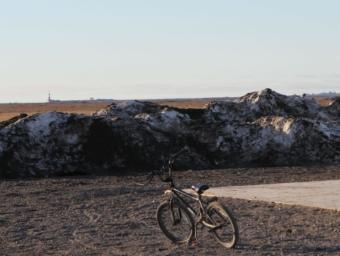
Between one-fourth and one-third of Nuiqsut’s traditional subsistence range is already physically impacted by oil and gas development, Kuukpik Corporation has reported in comments to the federal government. People in Nuiqsut are technically allowed to hunt near oil infrastructure if they follow certain rules. But many report avoiding traditional hunting spots near pipelines and other facilities.
Alaska’s political leaders often tout oil as a source of jobs and money for communities in the state. Itta had a different take.
“I want to make this clear: We are not rich people. We are not,” Itta said. “We do not get free oil and gas like people think we do. We pay $5-a-gallon for our gas — gas that’s coming right underneath us. Coming from right underneath our feet. Taking out all our resources. Changing our way of life.”
Concerns about oil development grew eight years ago, when an accident happened less than 20 miles from of the village. At a drilling pad operated by the oil company Repsol, natural gas and tens of thousands of gallons of mud spewed out of the exploratory well, flying beyond the pad and onto the tundra. An oil worker posted a video on Youtube showing the aftermath.
“Ain’t f—ing looking so good,” he said.
The Repsol blowout is one of many concerns raised in public meetings in Nuiqsut about future oil developments. Federal agencies post transcripts online:
“How many more lies are you going to tell us?”
“When are you guys going to listen to us?”
Nuiqsut residents’ concerns about the snowballing number of oil projects around them are real.
But what makes this already complicated story even more complicated is that it’s not a simple narrative of two clashing neighbors — the village versus the oil industry on its doorstep.
A big reason for that is Kuukpik Corp.
‘We’re providing’
When the oil industry decides to move to your neighborhood, you have a choice: You can fight, or you can negotiate, to try to make the best of things.
Kuukpik Corp. has gone with the second option.
Under the terms of the Alaska Native Claims Settlement Act, Kuukpik Corp. is the for-profit, landowning entity representing Nuiqsut’s indigenous residents.
Kuukpik owns approximately 146,000 surface acres, or about 200 square miles, surrounding the village. That’s the direct result of the 27 original families who pitched tents in the middle of the Arctic four decades ago, claiming the rights to their ancestral land.
Today, some of the children from those 27 families sit on Kuukpik’s board. One of those people is Isaac Nukapigak. He’s also a former whaling captain — an umailik.
“When I was a captain, I would take care of the community — elders, make sure they’re not starving, make sure they have the resources,” Nukapigak said. “Make sure that the wildlife that we harvest, that they get a share it.”
Nukapigak met for an interview on top floor of Kuukpik’s sleek office building in midtown Anchorage. Kuukpik now has several subsidiaries, including a drilling company. It also has a joint-venture partnership with SAExploration, the company trying to do early-stage oil exploration in the Arctic National Wildlife Refuge.
Sitting in a glass-walled conference room, Nukapigak described how being a whaling captain and sitting on a corporate board aren’t as different as one might think.
“You try to use the knowledge that you have as a captain, being a leader, and bring it to Western society through corporate structure,” Nukapigak said. “That’s kind of what we use in order to find balance.”
“Balance” — that’s a key word for Nukapigak and for Kuukpik Corp.
“I think it’s just balance, you know, oil. You’ve got to have a proper balance,” Nukapigak said. “And the benefits that the community enjoys…I know among other communities, it’s kind of like they’re jealous of Nuiqsut. Because we’re providing — we’re providing the community with benefits.”
In the way of whaling captains, Kuukpik is working to provide, but instead of with an animal harvested from the ocean, it’s with oil pumped from beneath their homeland.
And oil has benefited Nuiqsut in concrete ways. Nukapigak brought up a few examples, like the natural gas line that runs directly from Conoco’s Alpine oil facility to the village. People in Nuiqsut pay $25 a month to heat their homes — less than one-tenth of what people pay in some other rural Alaska communities.
And for every barrel of oil produced on Kuukpik lands, the corporation gets some of the royalty money. Some of those dollars go directly to Nuiqsut residents, many — thought not all — of whom are Kuukpik shareholders.
This year, the corporation’s original shareholders with 100 shares are set to receive some $30,000, Kuukpik confirmed, although not everyone in the village has that many shares, and some don’t have any. Nukapigak said that’s a issue that Kuukpik Corp. has been working to address.
Nukapigak does not think oil has robbed Nuiqsut of its other key resource: subsistence.
“Everything is still abundant. Caribou still roam through the community. Fish still come through. Waterfowl still fly in spring. Whales come through, they migrate,” Nukapigak said.
Kuukpik aims to thread the needle — to preserve Nuiqsut’s subsistence resources, land and traditions, while reaping the benefits of oil extraction. Pulling that off — well, that’s the trick.
‘We’ve got to earn their respect’
When up against one of the world’s most powerful industries, Kuukpik can hold its own.Using its leverage as the landowner, Kuukpik has entered into long, hairy negotiations. And it’s come out the other end with some success, forcing oil companies to make significant changes to their plans.
In 2005, Conoco proposed building a bridge over a river to access a drill site. But Kuukpik didn’t approve of the location — over a stretch of river where residents fish. And the quarter-mile-long structure wasn’t built until a decade later, after the oil company agreed to move it elsewhere.
Then, two-and-a-half years ago, Conoco decided to drill the closest-ever oil exploration well to Nuiqsut, three miles from the village. A number of residents were alarmed.
Conoco ended up delaying the project by a year. After months of negotiations with Kuukpik, the company agreed to several special measures — like powering its drill rig with low-emission generators, setting up more air and water monitoring equipment and taking extra steps to cut down on noise. Conoco also agreed to hire Kuukpik subsidiary companies as part of the project.
“It’s a relationship,” said Lisa Pekich, Conoco’s director of village outreach. “Sometimes we have difficult conversations in a relationship, probably like a marriage or any type of relationship. But we keep sitting down and we keep working together and I think overall, that openness and trying to collaborate on solutions has really been beneficial.”
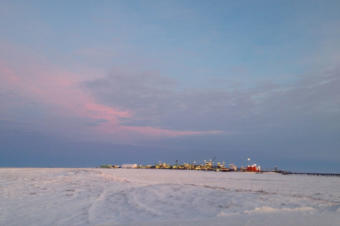
Conoco is eager to talk about what it brings to Nuiqsut, like job training programs, its work with kids and the new basketball court it helped build.
But the oil company is also aware of tensions in the village over oil development, and what its presence means for subsistence hunters.
“We recognize subsistence is critically important to the community — to their culture,” Pekich said. “They’ve maintained a very active subsistence lifestyle, which is great, because that’s what we want them to do. Recognizing our facilities are there physically… something that wasn’t there when they were growing up. So, there are some impacts that we have to acknowledge, just physically because we are there.”
Conoco has studied and worked with Nuiqsut on subsistence issues. And the company’s overall message seems to be that its impacts are manageable, that the village can thrive — isthriving — and that Nuiqsut stands to benefit, not suffer, from all the oil projects going up around it.
But the neighborhood is growing. There’s another oil company planning a major project next door, and it’s figuring out exactly what it means to do business on Kuukpik land.
Oil Search is a new-to-Alaska company headquartered in Papua New Guinea, leading the development of one of the most promising oil projects in the state. It’s called the Pikka development. It would be ten miles east of Nuiqsut.
As the project moves forward, Oil Search Alaska President Keiran Wulff said the company is working to understand Nuiqsut’s needs and concerns.
“I’m not sure how many presidents have even been to the villages on the North Slope as much as I have. Because I wanted them to get to know me,” Wulff said.
Oil Search publicly prides itself on its work with indigenous people in Papua New Guinea. Wulff acknowledged that Nuiqsut is different.
“We recognize that people in Nuiqsut don’t really know Oil Search,” he said. “And it’s something where we’ve got to earn their respect.”
And that’s an ongoing process. Kuukpik has a list of concerns about Oil Search’s project. A recent federal analysis determined while it’s being built, it will likely have major impacts on hunters’ ability to access caribou in the area. Wulff said his company has slowed its plans and made a number of concessions.
“We reoriented the roads to minimize the impact on caribou migration. We decreased the size of the footprint. We moved a drill site back significantly, which was at significant additional cost to the project,” he said.
Kuukpik has yet to support Oil Search’s development, although both sides report that progress is being made. Talks between the oil company and the Native corporation continue.
“Having a fair and equitable land use agreement with Kuukpik is our priority, and we are working closely with Kuukpik toward having an agreement soon,” an Oil Search spokesperson said in an email.
Already, though, Wulff is speaking Kuukpik’s language.
“This is about having a balanced development and ensuring that the Nuiqsut people have access to long term prosperity, sustainability, at the same time ensuring that they maintain their subsistence and their culture,” Wulff said. “It’s a balance.”
Balance — there’s that word again.
Balance implies there’s a fulcrum between two valuable resources — between a land rich in animals to eat, and a subsurface rich in fossil fuels. A fulcrum between a traditional culture and capitalist desires. It implies it’s possible for the two to coexist — that whaling captains providing food and corporate leaders providing money can stand next to each other on the same plane.
It also implies that it’s possible for that balance to tip.
When does that happen?
From the oil companies, the answer is: not yet. Not now, and if they do it right, not after they’ve finished drilling everywhere they want to drill, either.
For others, the answer is: it already has.
In late February, the Native Village of Nuiqsut joined with environmental groups to sue the federal government over its approval of Conoco’s plans to drill up to eight exploratory wells near the village.
“The impacts outweigh the benefits,” Itta, the tribal administrator, said the day the lawsuit was filed.
Two worlds
Nuiqsut’s cemetery is on the western edge of town, a gathering of white and brown wooden crosses behind a chain-link fence in the forefront of a great expanse of tundra. Frederick Tukle Sr., a smiling man in a blue sweatshirt smudged with dirt, was there on a June morning, fixing up the graves. Some of them have started sinking into the ground.
When the first oil well went up at Prudhoe Bay, Tuckle said, “we knew it was a matter of time before they reached here. And they did.”
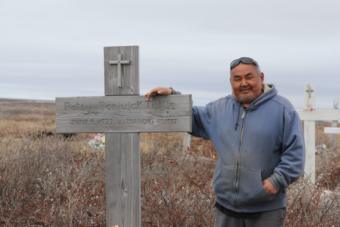
“And now we are completely surrounded with these oil activities,” he said.
Tukle has concerns about oil development. He talked about oil infrastructure deflecting animals that he and others hunt.
“And it hurt us,” he said. “We know that. But we learn to adapt and we learn to live in two worlds. Our Iñupiaq lifestyle sometimes can be seen as versus the oil companies. It can be seen that way. But there’s benefits, too. There’s benefits and losses.”
Two worlds, and what brings them together is the oil below both of them — below the drill rigs visible on the horizon, and below the elders and whaling captains resting under Tukle’s feet.
Home
Six years after Nuiqsut was re-settled, the community came together and approved a document that detailed the village’s history, its culture, its subsistence hunting and how it wanted to face its future.
On page seven, there’s a section that reads: “The people who live here, who hunt and fish and trap here, know this landscape throughout. There are no nameless valleys here, no places vacant of memory and association.”
“This is no frontier to be conquered. It is home.”
